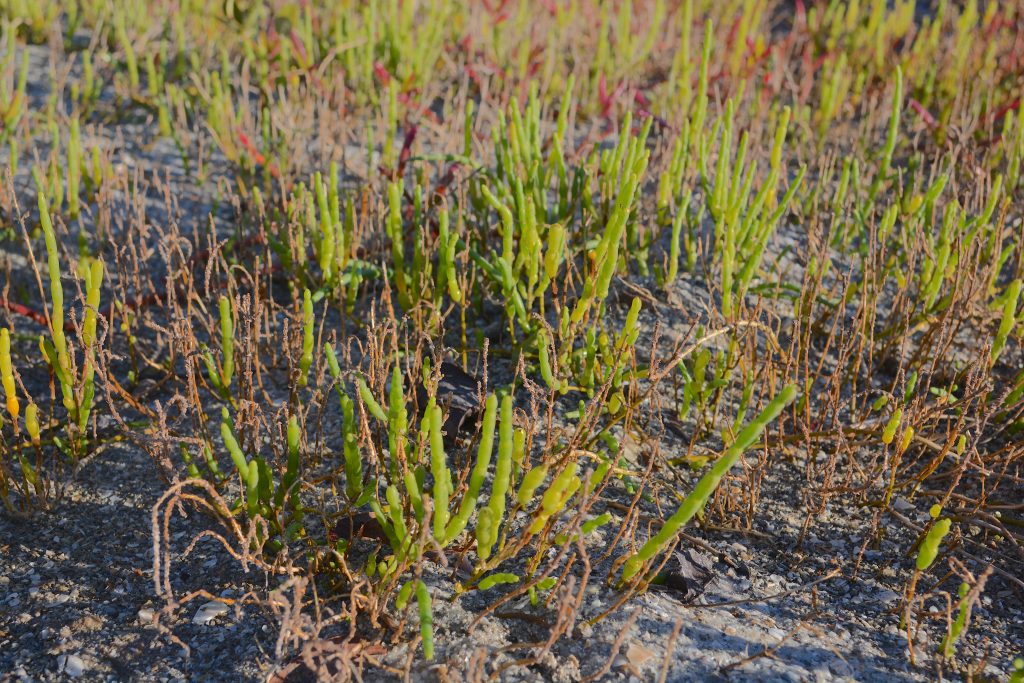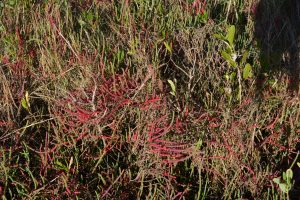
Glasswort, a tasty plant growing where others cannot. Photo by Green Deane
Salicornia bigelovii, Brackish Nibble
Glasswort does not sound like breaking glass at all, though it does crunch a bit.
Salicornia bigelovii (sa-li-KOR-nee-a big-eh-LOV-ee-eye) has been used by most indigenous people around the world. Like many other salt-tolerating plants, it grows in salt marshes, on beaches, and among mangroves. They are native to the United States, Europe, South Africa and South Asia.
There’s significant commercial interest in glasswort in that it can be watered with salt water and can produce an excellent and nutritious oil. The raw seeds themselves are not edible because of saponins, but those remain with the meal when the oil is extracted. It is similar to safflower oil in composition, has a nutty flavor with a texture like olive oil. An ash made from the plant was used in the manufacturing of glass, hence its name. Glasswort has also been used as a diuretic and an antiscorbuitic. l like it raw in salads.
Besides forager glasswort is the favorite of several butterflies particularly Lepidoptera species including the Coleophora case-bearers C. atriplicis and C. salicorniae, the latter which feeds exclusively on Salicornia. Salicornia means salt horn, referring to the plant’s branches. And Bigelovii: It was discovered in the New World by American botanist, Jacob Bigelow, right, 1787-1879. Of course, native Americans discovered it long before Jacob did. Professor Bigelow’s other claim to fame was he established the first rural garden cemetery in North America, Mount Auburn Cemetery in Cambrdge and Watertown, Massachusetts. He was not fond of doctors and was a vocal critic of their practices.
A close cousin to the S. bigelovii is the S. virginica (ver-JIN-ni-ka) meaning “of Virginia” read middle North America. Essentially the main difference is while the S. bigelovii can be stout the S. virginica tends to be trailing and forms mats on the ground. It is not as esteemed as its cousin but can be cooked and eaten the same way. However, it can be stringy so some folks like to put the cooked vegetable through a strainer to get rid of some stringiness. Another local species is S. ambigua, common on the local west coast.
Called Pickleweed and Woody Glasswort (from the sound some think it makes when you walk on it) glasswort can be found New Hampshire to Texas and up the Pacific coast. Often it turns red in the winter and red parts taste more salty. It has woody, jointed stems and leaves like fleshy sheaths. The flowers are extremely small, sunken into the joints, usually only the stamens visible. Four to 18 inches in height, it usually forms dense stands, miniature upright forests in tidal areas.

The more red the more salt. Photo by Green Deane
As with most greens, harvest when young and tender, or the growing tips. The entire glasswort grows woody as it ages, but in stages. You may find when you go to chop it that you have some with a thin woody core and fleshy on the outside. Just bend up those pieces and boil them any way. When they are done, the fleshy green exterior can be easily stripped of the inner light yellow wood. Toss the woody parts away. For raw in salads and as pickles pick the youngest parts possible and keep checking for a woody core, which you don’t want if you aren’t going to cook them. Older pink parts of glasswort can be used to make salt or for seasoning. Incidentally, the ash, which can be used for making glass and leaching lichen, is also good for making soap, especially if you don’t have hard wood ashes available for soap .
Green Deane’s “Itemized” Plant Profile
IDENTIFICATION: Glassworts are succulent, fleshy plants with opposite leaves and jointed stems, found in saline environments. Plant, 2 to 12 inches, erect, may turn red in winter. Leaves very small, scale-like. Flowers tiny, sunken into stem joints, commonly only stamens visible. Joints wider than long. Fruit small, succulent containing one seed.
TIME OF YEAR: All year round
ENVIRONMENT: Salt marshes, and along interior salt lakes.
METHOD OF PREPARATION: Young leaves and stems, raw, cooked or pickled. Oil pressed. Another species, S. perennis, is likewise usable after cooking but should be strained. Scalornia gets woody as it ages and is not edible.
HERB BLURB
Salicornia bigelovii Torr.: An Oilseed Halophyte for Seawater Irrigation
EDWARD P. GLENN 1, JAMES W. O’LEARY 1, M. CAROLYN WATSON 1, T. LEWIS THOMPSON 1, and ROBERT O. KUEHL 2. 1 Environmental Research Laboratory, 2601 East Airport Drive, Tucson, AZ 85706
2 Statistical Support Unit, College of Agriculture, University of Arizona, Tucson, AZ 85721
The terrestrial halophyte, Salicornia bigelovii Torr., was evaluated as an oilseed crop for direct seawater irrigation during 6 years of field trials in an extreme coastal desert environment. Yields of seed and biomass equated or exceeded freshwater oilseed crops such as soybean and sunflower. The seed contained 26 to 33 percent oil, 31 percent protein, and was low in fiber and ash (5 to 7 percent). The oil and meal were extracted by normal milling equipment, and the oil was high in linoleic acid (73 to 75 percent) and could replace soybean oil in chicken diets. The meal had antigrowth factors, attributed to saponins, but could replace soybean meal in chicken diets amended with the saponin antagonist, cholesterol. Salicornia bigelovii appears to be a potentially valuable new oilseed crop for subtropical coastal deserts.



I was wondering If you know how to make soap out of glasswort or any other plant for that matter.
Hey Jeff if i’m not mistaken you can make soap from fire ash hard wood white ash and fat.not totally sure on the cook time but I know the ash is alkali and the fat acts like a binder and kinda a moisturizer I think primitiveways.com has an article on it, pretty good website when you learn from deanes website on what to eat and from primitive ways how to fashion your own crude utensils to prepare the wild edibles.check around for the recipe
I enjoyed greatly the way you produce these and give the imformation / I just found your work yesterday and now have spent hours watching / love it and have taught some of church children some of what you are know giving me a lot more to work with / thanks / lord bless / ron
It was discovered long before 1787 by the French Acadian people in the early 15th century in Atlantic Canada . It played a crucial role in their survival in 1755 when the English deported them while other fled or where in hiding , I am a direct descendant of these Acadian people living in Memramcook one of the original settlement. Jacob bigelow wasn’t the first to discover it but simply the first to publish an article about it . This plant was shown to us by the mic Mac aboriginal people , I hope this cleared it up thanks for reading!
Do you know if salicornia oil is sold for personal use? If so where could I purchase a bottle? I would like to use some for soap making.
Salicornia plants is available
we can provide Salicornia oil
Does anyone know why it turn red in the fall?
The article explains why, the sequestration of salt.
I need to buy the seed of salicornia,can anyone help me with this?i live in Canada and if any one knows the company that sell these seeds in Canada or US please help,thanks..
I need help find Salicornia Bigelovii seeds or live plant for and an independent extreme green lab project.
Hi , do you know how to extract the seeds? I have wild salicornia ( I think is salicornia fructicosa) and I need to grow it from seeds to see if it grows in a specific saline soil that I have . One more question, I tried to transplant the wild salicornia in a pot I don’t know if I did it right ): how many times a day should I water it ? I’m from Perú, here not many people know about salicornia so I have no one to ask about care and handling of this plant. Really hope you can help me. Thank you !
enjoying your iformation. I have very high blood pressure and it has been suggested to use glasswort powder for salt. Can you give me any information if glasswort can be used and will not effect blood pressure. Thank you.
Well… glasswort is full of salt…
Good afternoon. My name is Alexander. I live in Ukraine, collecting, processing, drying, Salicornia Europaea (wild, in an ecologically clean place, in any form in large quantities (tons-kilograms) according to your requirements. Also Salicornia Europaea seeds and oil. I am looking for a wholesale buyer for Salicornia Europaea (Wild Salicornia, Samphire, Sea Beans, Sea Asparagus, Saltwort, Glasswort). The most important thing for you as a buyer is that the price will be lower than that of any supplier. +380984476495 (all messengers) mrbelalx@gmail.com